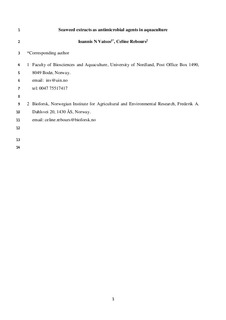| dc.description.abstract | In the last 20 years, there has been an increasing interest in using various seaweed extracts as prophylactic and/or therapeutic agents in aquaculture. Up until now, most studies on the direct antimicrobial effect of seaweeds have taken place in various parts of Asia, particularly in India. All groups of seaweeds exhibit significant antimicrobial properties against many infectious agents of fish and shrimp, but the genera that appear to exhibit a broader range of antibacterial properties are Asparagopsis spp. (red seaweed) and Sargassum spp. (brown seaweed). The activity can be affected by many factors and the method of extraction is one of the most important ones, as the extracts that are produced using organic solvents appear more efficient. In fish, almost all published information on bacterial pathogens comes from in vitro screenings, where extracts of different seaweed species were tested against many bacterial species. On the other hand, in shrimp, the studies have been focusing on the antimicrobial effects of seaweed extracts mainly against many Vibrio species. Regarding the viral pathogens, in fish, there is only one published study on fish viruses (IHNV and IPNV), while in shrimp there are many studies on WSSV. There are only two published studies on fish parasites (Ichthyophonus hoferi and Neobendenia spp.) and no studies on pathogenic fish and shrimp fungi. Interestingly, there are no published studies on salmons and carps, the main fish species that are extensively farmed. When the antimicrobial properties were studied in vivo, the seaweed extracts were either incorporated directly in the feeds (dry or live) or added directly into the water in which the fish and shrimp were reared. In the last case, the water-soluble antimicrobial seaweed substances affected the communication between the bacterial pathogens, rather than their growth. The development of parasites was also affected. In addition, one study indicated that short-term immersion of shrimp in seaweed extracts appeared to have a therapeutic effect against Vibrio parahaemolyticus. On the other hand, incorporation of the extracts into the feeds appeared to be an effective delivery method for the prevention and treatment of different infectious diseases. Up until now, there are no complete studies on the pharmacodynamics and pharmacokinetics of seaweed extracts in fish or shrimp. However, the findings indicate that they can reduce the bacterial load within the tissues. Another issue that has not been examined yet is the applicability of using these extracts on a commercial scale. Currently, the increased extraction cost inhibits the extensive use of these extracts. Other methodologies, such the production of synthetic analogues with similar properties, may decrease the production cost. Based on the published studies, seaweed extracts exhibit promising antimicrobial properties, but further research is needed before the complete potential of seaweed extracts is assessed. | nb_NO |
